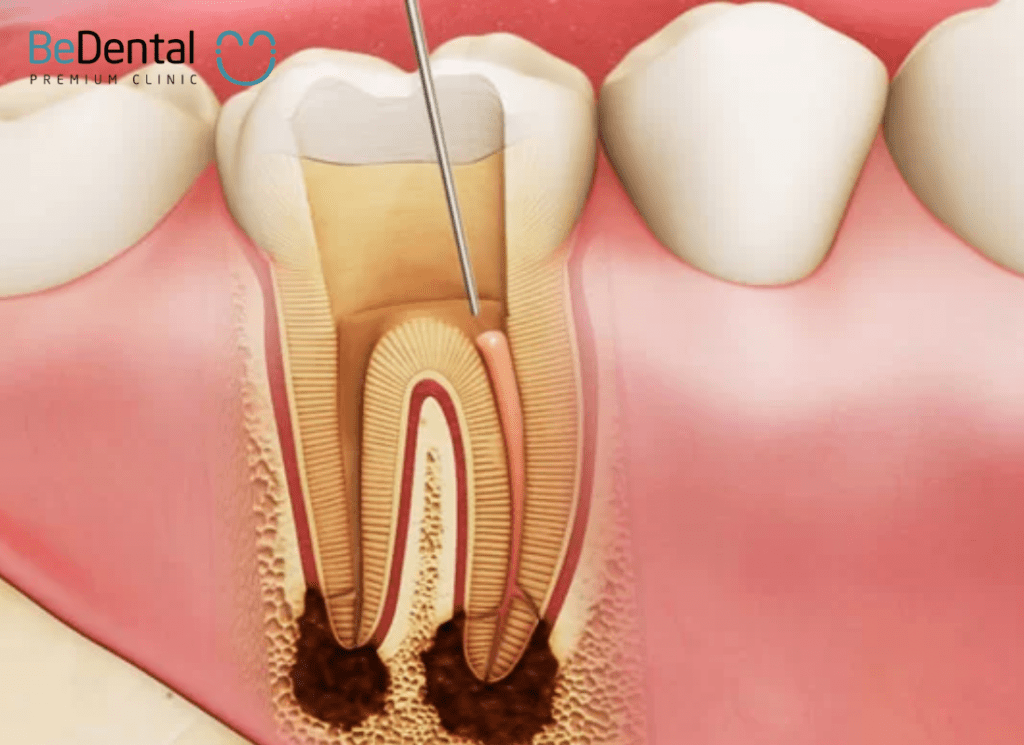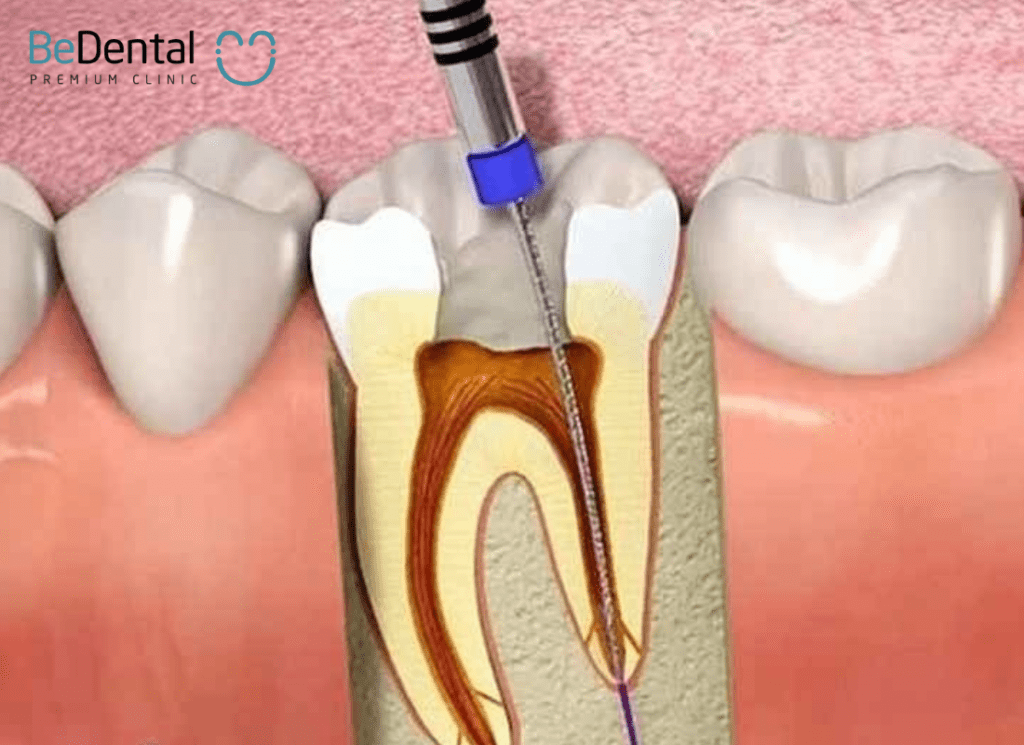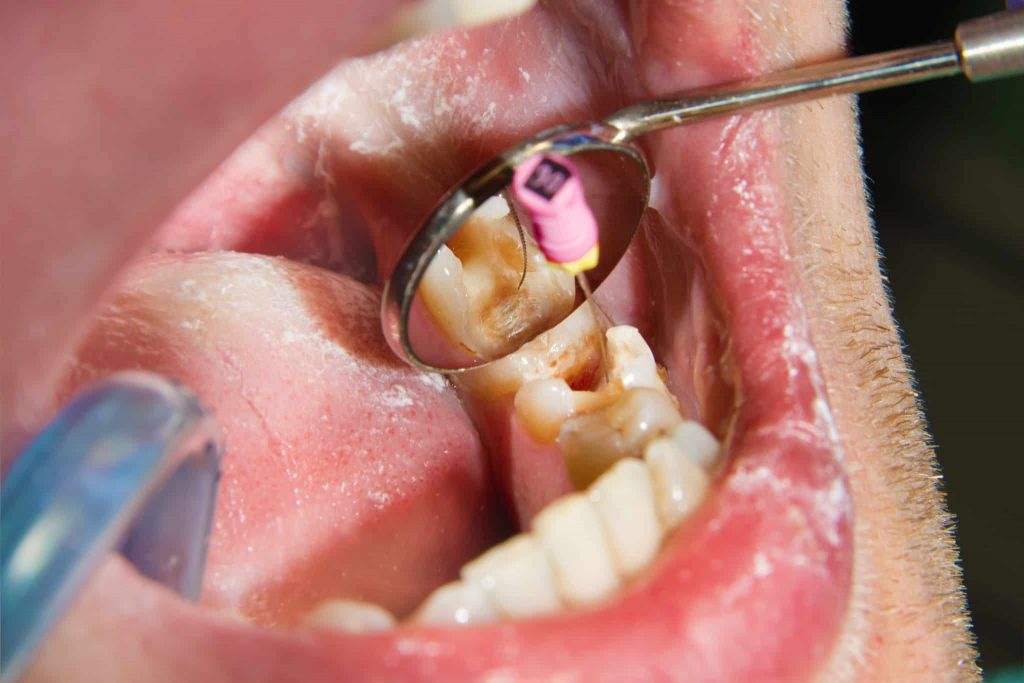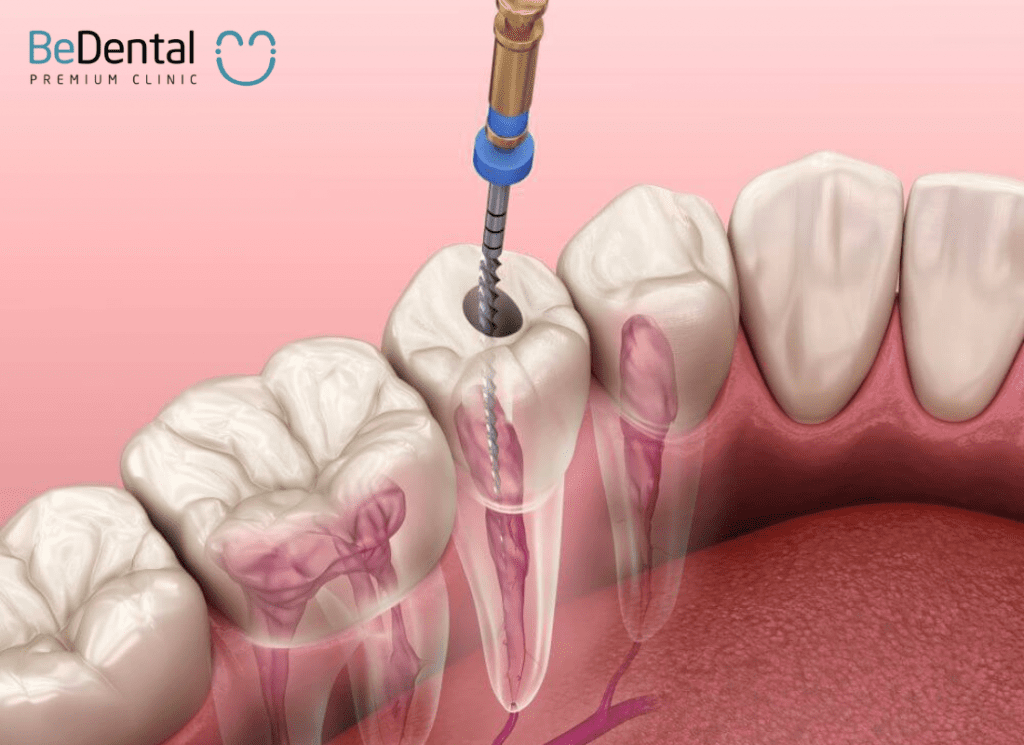Procedure for performing a root canal treatment. So, is pulp removal dangerous? In which cases is it necessary to extract the pulp? How is the procedure performed, and how much does it cost? Let’s delve into the following article from BeDental to fully address these questions.
I. Understanding the method of pulp removal
The dental pulp is a vital part located inside the core of the tooth, responsible for providing nourishment to the tooth. Within the dental pulp, there is a system of nerves and blood vessels surrounded by dentin and enamel.
To analyze further, the dental pulp consists of two parts: the pulp chamber and the root canal. When the molars are affected by pulpitis, it negatively impacts the supporting structure of the tooth. If left untreated for a long time, pulpitis will fail to supply enough nutrients to the tooth. Consequently, the tooth will weaken, and during an examination, the dentist will decide whether to pursue conservative treatment or extract the pulp.
Pulp extraction is the process of removing dead, inflamed, or necrotic pulp from the tooth. Then, the dentist will clean the inside of the root canal and fill the empty spaces with specialized dental materials such as composite or porcelain.

II. What is molar pulpitis? Is it serious?
2.1. Definition of molar pulpitis
Molar pulpitis is a protective response of the dental pulp to disease-causing agents. When affected by pulpitis, the disease progresses through different stages such as reversible pulpitis, acute pulpitis, and chronic pulpitis.
In most cases of molar pulpitis, dentists prioritize pain management before treating the pulpitis, such as removing the pulp and sealing the root canals. Both before and after treatment, maintaining good oral hygiene is necessary to prevent tooth decay.
What should you do for a dislocated jaw? Some treatment methods you should know
2.2. Is molar pulpitis serious?
Molar pulpitis is a relatively serious dental condition that requires early treatment to avoid dangerous complications such as:
- Pulpitis can quickly spread to periodontitis and tooth abscess. As a result, patients often experience toothache, facial swelling, cheek swelling, and it affects their eating and daily activities. Additionally, there is a risk of abscess formation.
- Untreated molar pulpitis can lead to pulp necrosis. This can result in the destruction of the entire tooth structure, including the crown and root, potentially leading to permanent tooth loss.
- Infection from molar pulpitis tends to spread to neighboring teeth, significantly affecting chewing function and overall aesthetics of the jaw.
- When affected by pulpitis, there is a high risk of developing jaw bone infection.
- For individuals with cardiovascular diseases or diabetes, the presence of an infected molar pulp provides a favorable environment for bacterial colonization, which can worsen the condition and pose a greater threat.
III. Should a root canal be performed for molar pulpitis?
No one wants to undergo a root canal procedure. However, in cases where the pulp is severely damaged, not performing a root canal treatment can be extremely dangerous as it carries the risk of infection, permanent tooth loss, or even a threat to life.
When a root canal is necessary, it is important to accept that the affected molar will no longer be nourished and will weaken over time. Chewing food may not be as efficient as before, and the sense of taste may also be affected due to the absence of pulp.

IV. In which cases is it necessary to perform a root canal for molar pulpitis?
The molar teeth are among the most important teeth that need to be protected from damage, and interventions such as root canal treatment or extraction should be minimized. So, when is it necessary to perform a root canal?
Cases in which a dentist may diagnose and recommend a root canal for molar pulpitis include:
- The intensity of throbbing pain in the molar area increases over time, and when touched, you feel that the tooth is loose.
- The sensation of throbbing pain is not limited to the oral cavity but tends to radiate to the jawbone. Medications are no longer effective, and the pain persists, especially at night.
- The molar tooth is overly sensitive to hot, cold, and acidic foods. Additionally, if the tooth has cavities, when food gets trapped in them, you may experience sharp, throbbing pain.
- The gum area around the molar is swollen and no longer appears healthy and pink.
How to Stop Bleeding after Wisdom Tooth Extraction? Some Ways to Control Bleeding

V. Does a root canal for molar pulpitis hurt?
Does a root canal for molar pulpitis hurt ? In the past, the conventional method of root canal treatment could cause intense pain as the procedure somewhat affected the nerve fibers. Additionally, the outdated equipment at that time made it difficult to accurately determine the length of the root canal or the extent of inflammation in the molar pulp.
However, there is no need to worry too much because modern root canal techniques for molar pulpitis are not painful like the old method. With the support of advanced machinery, dentists can make an accurate diagnosis and perform quick and effective treatment to thoroughly address the molar pulp infection.
Furthermore, the use of local anesthesia will ensure that you do not feel any discomfort during the process of removing the pulp. After the anesthesia wears off, you may experience slight sensitivity, throbbing pain, but this discomfort will only last for a short period and gradually diminish over time.

VI. Standardized and Complication-Free Procedure for Performing a Root Canal Treatment
Performing a root canal for molar pulpitis requires the expertise of a dental team. To avoid potential complications, it is recommended to seek reputable dental clinics that follow a high-quality root canal procedure with the following steps:
Step 1: Comprehensive oral examination
A comprehensive oral examination is crucial in any dental treatment, especially in root canal therapy. Firstly, the dentist will take X-rays to assess the condition of the affected molar. This includes evaluating the presence of cavities, previous dental restorations, pulp chamber, root canal system, infected periodontal tissues, and bone support. Based on these findings, the dentist will diagnose and develop an appropriate treatment plan for the affected tooth.
Next, the dentist will discuss the treatment plan with you, including the estimated duration and cost of the procedure. This discussion is important to ensure that the patient understands the treatment process.
Step 2: Oral hygiene and local anesthesia
To eliminate bacteria and reduce the risk of infection during the root canal procedure, the dentist will first perform thorough oral hygiene procedures.
After ensuring a clean oral environment, the dentist will administer local anesthesia to ensure a pain-free root canal procedure. This anesthesia will also facilitate the dentist in performing the necessary steps. However, if the pulp is already non-vital, anesthesia may not be required, and the pulp can be removed without discomfort.
Step 3: Placement of rubber dam
During the root canal procedure, the dentist will isolate the affected tooth using a rubber dam. This isolation prevents instruments, irrigants, or saliva from entering the mouth and ensures a sterile and dry working environment.
Step 4: Root canal treatment
This is a critical step that requires the expertise of the dental team. First, the dentist will use specialized instruments to gain access to the pulp chamber and remove the infected pulp tissue. Then, the root canal system will be thoroughly cleaned and shaped. Various irrigants will be used to ensure comprehensive disinfection.
The duration of the root canal treatment and the specific steps involved may vary depending on the severity of the infection. If multiple appointments are necessary, the dentist may place medication inside the root canal system to aid in disinfection and temporarily seal the tooth, allowing the patient to eat and drink comfortably without the risk of reinfection.
In addition, depending on the individual’s oral health condition, the dentist may prescribe antibiotics, pain medication, or mouthwash after the root canal treatment.
Step 5: Sealing the root canal
Once the root canal system is thoroughly cleaned and shaped, and the infection and inflammation are resolved, the tooth will no longer experience pain or discomfort. At this stage, the dentist will seal the root canal with specialized dental materials.
The coronal part of the tooth will be restored using dental restorative materials. In some cases, a post may be placed inside the root canal to provide additional support for the restoration.
Finally, a suitable dental crown or restoration will be placed to cover and protect the tooth, ensuring proper function and longevity of the treated molar.

VII. How much does a molar root canal cost?
How much does a molar root canal cost ? The cost of a molar root canal is a matter of concern for many patients. This is because molars are one of the most important teeth. Underneath the molars are also connected to many nerve fibers in the body, so the process of removing the pulp must be carried out meticulously step by step.
Currently, the price of a molar root canal typically ranges from 900,000 to 1,200,000 VND. If there are other dental conditions, there may be additional costs as dental treatment may be required before the molar root canal can be performed.

VIII. How to take care of your oral health after treatment and molar root canal extraction
To ensure safety and avoid complications, what should you do after extracting a molar? After having the molar pulp removed and extracting the tooth, you should take note of the following:
- Monitor any pain to determine whether it is normal or abnormal and seek timely intervention and treatment.
- Limit biting and chewing at the site of the extracted molar.
- Prioritize soft foods and cut them into small pieces to avoid the need for biting and tearing, creating pressure for chewing.
- Strictly follow the prescribed medication from your dentist.
- Maintain oral hygiene as instructed by your dentist.
- Schedule a follow-up appointment immediately if you experience any loosening or breakage of the dental filling.
- Regularly visit the dentist for oral check-ups to assess if there are any complications after the pulp extraction.
This article has shared with you the standardized and high-quality procedure for molar root canal extraction, as well as the pricing information to help you better plan your finances. If you have any other questions, please contact BeDental for consultation and support.
IX. BeDental – A reputable dental clinic for safe and complication-free molar root canal extraction
Currently, there are many dental clinics that offer molar root canal extraction services. However, to ensure a safe, painless, and complication-free extraction process, it is advisable to seek reputable dental clinics such as BeDental.
With the advantage of having a team of top-notch dental experts and modern equipment, BeDental ensures a safe and painless molar pulp treatment process without any unintended complications.
The molar root canal extraction procedure is performed in a sterile room by experienced dentists with many years of hands-on experience. Therefore, you can feel completely confident when choosing to undergo root canal treatment here.
Regarding the cost of molar root canal extraction, BeDental is transparent and provides specific pricing information before proceeding with the treatment. You can directly contact our hotline for free assistance.
What is Vecni Flour? How to use it? How old can children use it and some notes.
Tư vấn chuyên môn bài viết:
BÁC SĨ ĐÀM TRỌNG HIẾU
BEDENTAL - TOP STANDARD DENTISTRY SYSTEM
In HANOI
Address 1: 7B Thi Sach St, Ngo Thi Nham, Hai Ba Trung Dist, Ha Noi. - 0934.61.9090
Address 2: No 129 Hoang Ngan, Yen Hoa, Cau Giay Dist, Ha Noi. - 0934.61.9090
In HO CHI MINH
Address 1: 53 -55 -57 Pho Duc Chinh St, Nguyen Thai Binh, Dist. 1, Ho Chi Minh. - 0766.00.8080
Working: 9am - 8pm everyday
Website: https://bedental.vn/en/






Pingback: Trần Thế Anh “exposes” BeDental Dental Clinic after 7 years of getting porcelain veneers – Be Dental
Pingback: Ways to Prevent Tooth Decay – Why Do You Still Get Cavities Despite Regular Brushing – Be Dental
Pingback: Conditions/Procedures for Operating Dental Services (Dental Clinic): Costs of Opening a Dental Clinic – Be Dental
Pingback: Can I get dental Scaling and teeth whitening done at the same time? Should I get dental scaling regularly – Be Dental
Pingback: Choosing between dental fillings for tooth erosion teeth or dental crowns – Be Dental
Pingback: How much does jawbone grafting cost? Latest price list. – Be Dental